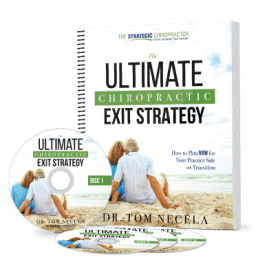If you are looking to buy a chiropractic business and seeking chiropractic practice financing, there are some important factors that will contribute to your success or failure to find a purchase loan. Understandably, many chiropractors have little experience or knowledge with respect to chiropractic practice financing. It certainly wasn’t a topic taught to us in chiropractic school. So most DC’s looking to buy a practice find too little information, too late in the game.
In today’s post, we’re going to discuss what I call the “Four C’s” of chiropractic practice financing. Think of these as the four essential ingredients in a successful loan package. Certainly, other criteria can be applied. But without these four, you are generally in a situation where a loan is impossible.
The 4 “C’s of Chiropractic Practice Financing
Credit We’ll begin with the factor that probably confuses chiropractors the most and that is your credit score. As you would expect, a better credit score will increase your chances for a loan. For most chiropractic practice financing scenarios, this is going to mean a score of 700+. What many DC’s don’t understand, however, is that lenders can be somewhat flexible with this requirement. For example, a smaller loan, a lender may decide that a 680 credit score is fine. Similarly, banks can permit larger loans with less than perfect scores, but they may offered at a higher interest rate. The take-home message here is that your credit score is important and will definitely impact your ability to get a loan and/or the attractiveness of the loan terms and interest rates. But it’s only one criteria of four – so don’t stop there.
Cash most lenders would consider Cash to be the most important criteria of the four. Many practice purchase loans are going to be available through the Small Business Administration (SBA) lending programs which require a minimum 10% downpayment based on the purchase price. If you do not have 10% for a downpayment however, do not lose heart! Some lenders will permit you to split the downpayment requirements with the Seller to meet the minimum so that you can actually purchase with as little as 5% downpayment! This rule was relaxed back in 2018 and has opened the doors to chiropractic practice financing for many more people. (For a more detailed discussion, on this, see here) To be clear, if the Seller is willing to permit a “Carryback Loan” the bank may reduce your downpayment requirement. What this means is that you will pay the Seller over time, for the remaining 5% in lieu of your downpayment.
For example: if you are purchasing a $300,000 practice but do not have $30,000 (10%) for a downpayment, it is possible (depending on the bank and the Seller’s willingness) to put 5% down ($15,000) and have a Seller Carryback note for the other 5% ($15,000). In this scenario, the bank would lend $270,000 (90% of your sale price) and you would put down 5% ($15,000). At closing, the Seller would receive $285,000 and you would sign a Promissory Note to pay the Seller the remaining $15,000 in installment payments over time.
**2023 UPDATE** With Seller financing, it is now possible to get an SBA loan to purchase with a downpayment as little as $0 — see our post here –> Zero Down Chiropractic Practices for Sale: How the New SBA Rules Can Go In Your Favor.
Again, these scenarios are not available with all banks or with all Seller and sale situations — but we have a network of lenders who DO offer these terms! For those who have less cash on hand than the standard 10% for a practice purchase, this represents an excellent option and opportunity to be able to buy more, with less!
Collateral In the absence of or in addition to Cash, the next important item in chiropractic practice financing is Collateral. The reason is simple: the bank is lending the Buyer money and wants Collateral in order to ensure that, if the loan is not repaid, the bank can recoup its losses somehow. In a practice purchase situation, Collateral can come from several sources. The practice you are purchasing has some Collateral in the form of tangible equipment. In other words, if you failed to pay your loan, the bank could take and sell the business equipment to make up for outstanding loan payments. Similarly, if you are purchasing both the practice and the real estate, the bank will use the building as collateral. It is also possible (and probable) that Collateral may come from sources outside the practice. For example, if you have a house or other assets, the bank may ask you to pledge those as Collateral, again, in case you don’t pay your loan. To be clear, the point here is not that you are giving up those assets, they are to act as “backup” for the bank. If you pay your loans as scheduled, your collateral is unaffected. Finally, collateral can even come from outside the practice and your personal assets. Most commonly, a parent or family member can agree to pledge their assets to act as Collateral for your loan. This is seen in a Co-Signer or Co-Guarantor situations where your lack of cash (or possibly credit score) is strengthened by the Collateral of your parents or family.
Competence The most subjective and perhaps least important of the four criteria is Competence. Since there is no way that a lender can truly determine that you are a good chiropractor in terms of technique or skill, they attempt to asssess your competence in two ways. First, most banks want to see 2+ years recent “industry experience.”
The simple translation here is that you have worked for two years as a chiropractor, either as an associate, independent contractor or owning your own practice. The second way a bank assesses competence is through the submission of a Business Plan or through use of their own questionnaires asking about how you plan for the business to succeed under your ownership (and how you can ensure them that the loan will be repaid). Again, here it is difficult for banks to understand the specifics of how successful chiropractic practices operate, but they expect you to make a commonsense demonstration of how you plan to keep the business running, anticipated expenses and how you plan to grow the practice.
The reason that I would state that “Competence” is the least important of the four C’s is pretty simple. If you apply for a loan with great credit, adequate cash and collateral, the bank will probably be pretty generous (or even ignore) the Competence factors since they are fairly subjective anyway. Along the same lines, in the absence of industry experience, the first 3 C’s are what really matter most.
Case in point: every year we have several chiropractic practice financing applications approved where the Buyer does not meet the classic “Competence ” critiera. Most notably, we had a loan for a Buyer who, interestingly enough, had zero work experience. The Buyer went straight from High School to College to Chiropractice School to buying a practice. Yes, the Buyer was a new graduate! As you might imagine, the Buyer’s credit score was excellent and it certainly did not hurt that the Bank of Dad donated the Cash for the Downpayment and pledged his house as Collateral. The bank approved a $350k purchase loan.
In another example, we got a chiropractic practice financing loan approved for a Buyer who was only six months fresh out of school. The buyer bought a business and a building for total sale that topped $1.2 Million. Obviously, according to SBA terms, the Buyer did not meet the 2 year minimum industry experience. But, as you may guess, the Buyer also has excellent credit, owns a house (for collateral) and has 5% for a downpayment. The Seller is willing to a 5% Carryback Loan and the building that the Buyer is purchasing is also acting as Collateral.
Looking Beyond the Four C’s While the 4 C’s are important and will make up the bulk of the criteria that the bank uses to assess your chiropractic practice financing application, I share these examples to show you that, if you are interested in purchasing a practice and have the other 3C’s lined up, it can be done. Also, I cannot emphasize enough how important it is to choose banks wisely. Chiropractors can have the 4 C’s present, but there is typically one strike against them when it comes to student loans. Since most DC’s have sizable student debt, it’s critical to work with banks that understand healthcare practice lending and have experience looking beyond your student debt.
Finally, if you need assistance with chiropractic practice financing for a purchase that you are considering, contact us and we’d be happy to discuss your situation.
Need to Learn More about Buying a Chiropractic Practice (& Loan Options)? Consider our FREE ON-DEMAND webinars and videos designed to help you learn more about buying or financing a chiropractic practice.
Need to FIND a Practice to Buy (Or an Associate Job or Ownership Opportunity)? Our FREE Practice Match service will help you do exactly that! Just fill out the form, tell us your interests and let us find you a great fit!









